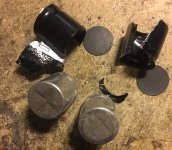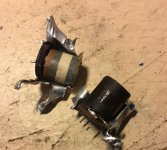Hey everyone.
I have a few Nichicon GU 5600/50V capacitors. I salvaged them from a cheap china amplifier kit. I want to use 4 of these in a amplifier which only has 2x4700uf/50v caps. However the only GUs I can find with this capacity are black with white markings. Mine are some kind of green colour.
How can I make sure they are not fake?
I have a few Nichicon GU 5600/50V capacitors. I salvaged them from a cheap china amplifier kit. I want to use 4 of these in a amplifier which only has 2x4700uf/50v caps. However the only GUs I can find with this capacity are black with white markings. Mine are some kind of green colour.
How can I make sure they are not fake?
Can't help you with the detective/forensic work, but I suggest than more important than that is whether they match specs or not.
And you can test them using the amp you already have.
I guess it has close to 100V power supply (say, +40/-40V or 80V end to end)
1) test voltage: apply said 80V to one of the suspect caps, through a 1K resistor .
It will not charge to full 80V but (hopefully) to a larger than 50V value, say 60 to 70V .
Label it and repeat for all others.
If so, I wouldn't worry about using them in a <50V supply.
2) test capacitance:
first discharge them, then connect to said 80V through a 100K resistor.
Chronometer time needed to reach 63% of supply voltage (in this case 0.63*80=50V) .
Use that "x" time in the RC time constant formula .
Since you know R (100K) and T (what you just measured) you can calculate C .
Cool, huh?
EDIT: if they meet or comfortably exceed specs, I couldn't care less about brand.
And you can test them using the amp you already have.
I guess it has close to 100V power supply (say, +40/-40V or 80V end to end)
1) test voltage: apply said 80V to one of the suspect caps, through a 1K resistor .
It will not charge to full 80V but (hopefully) to a larger than 50V value, say 60 to 70V .
Label it and repeat for all others.
If so, I wouldn't worry about using them in a <50V supply.
2) test capacitance:
first discharge them, then connect to said 80V through a 100K resistor.
Chronometer time needed to reach 63% of supply voltage (in this case 0.63*80=50V) .
Use that "x" time in the RC time constant formula .
Since you know R (100K) and T (what you just measured) you can calculate C .
Cool, huh?
EDIT: if they meet or comfortably exceed specs, I couldn't care less about brand.
Poor print and ill fitting sleeving are very common and often the print comes off with rubbing alcohol.
The top markings/vent are unique to the different brands, and this is often wrong.
Lots of fake dark green Nichicon around. maybe they are relabeled Changxin capacitors. For some reason Changxin have copied the Nichicon vent shape... I wonder why 🙄
Although...there is a chance they are all genuine Nichicon. Salvaged, polished and re sleeved.
Most fakes seem to have acceptable capacitance but voltage rating can be lower.
I found these in the PSU of my 3dprinter. Different/wrong vent shape is a dead give away.
The top markings/vent are unique to the different brands, and this is often wrong.
Lots of fake dark green Nichicon around. maybe they are relabeled Changxin capacitors. For some reason Changxin have copied the Nichicon vent shape... I wonder why 🙄
Although...there is a chance they are all genuine Nichicon. Salvaged, polished and re sleeved.
Most fakes seem to have acceptable capacitance but voltage rating can be lower.
I found these in the PSU of my 3dprinter. Different/wrong vent shape is a dead give away.
Attachments
snippage
Although...there is a chance they are all genuine Nichicon. Salvaged, polished and re sleeved.
Most fakes seem to have acceptable capacitance but voltage rating can be lower.
Ah, so if the voltage rating is lower and we apply voltage according to the
JMF (post #2)...lets see how long before it blows?
Or wondering how would we really know what the voltage is?
Do we put it behind a screen and let it blow up?
or
measure the time to whistle,fiz,pop?
So in the above example, if the cap is really a 10V cap
and we apply 80V based on the assumption it's a 50 volt cap
and at 63 % is our target time....
Where do we measure the voltage for it, across the + - leads of the cap
when we're charging it up?
cheers,

